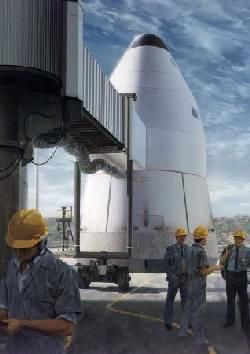
Home - Search - Browse - Alphabetic Index: 0- 1- 2- 3- 4- 5- 6- 7- 8- 9
A- B- C- D- E- F- G- H- I- J- K- L- M- N- O- P- Q- R- S- T- U- V- W- X- Y- Z
VTOVL
 Phoenix 1985 Credit: Gary Hudson |
Bono's vehicles proposed minimizing weight by using plug nozzle engines. Cooled by residual hydrogen fuel, these would act as a heat shield for re-entry. More conservatively the recent DC-X designs used a conventional forward heat shield for reentry. The concept was not selected by NASA for the X-33 (an even more risky lifting body design was chosen). This was perhaps the last chance for the concept. The more conservative Kistler recoverable reusable ballistic launch vehicle uses two stages, thereby minimizing the risk.
| VTOVL 1978 American SSTO VTOVL orbital launch vehicle. Vertical Takeoff Vertical Landing. |
Back to top of page
Home - Search - Browse - Alphabetic Index: 0- 1- 2- 3- 4- 5- 6- 7- 8- 9
A- B- C- D- E- F- G- H- I- J- K- L- M- N- O- P- Q- R- S- T- U- V- W- X- Y- Z
© 1997-2019 Mark Wade - Contact
© / Conditions for Use